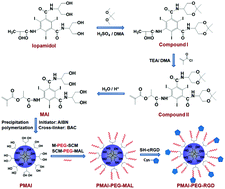cRGD-modified and disulfide bond-crosslinked polymer nanoparticles based on iopamidol as a tumor-targeted CT contrast agent†
Abstract
Among all X-ray tumor diagnostic imaging modalities, computed tomography (CT) has been most commonly used owing to its high spatial resolution and high detection efficiency. In order to achieve enhanced CT imaging on tumors, methacrylated iopamidol based polymer nanoparticles with disulfide bond crosslinking were prepared and then surface-modified with a cyclo[Arg-Gly-Asp-(D-Phe)-Cys] (cRGD) peptide through the linkages of poly(ethylene glycol) (PEG). The resultant poly(methacrylated iopamidol)-polyethylene glycol-cRGD (PMAI-PEG-RGD) nanoparticles were well-dispersed and had a relatively high X-ray attenuation coefficient. Compared to the nanoparticles without the modification of cRGD, PMAI-PEG-RGD nanoparticles showed specific uptake by 4T1 cells that over-express αvβ3 integrin. After being intravenously injected into 4T1 tumor-bearing mice, PMAI-PEG-RGD nanoparticles reached the tumor and further accumulated there efficiently, thus greatly enhancing the contrast of tumor CT imaging. In summary, PMAI-PEG-RGD nanoparticles have great potential to be used as a novel CT contrast agent for breast cancer-targeted imaging.



 Please wait while we load your content...
Please wait while we load your content...